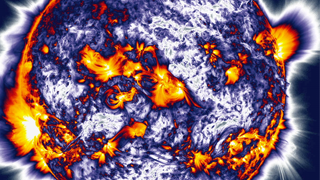Gradient Sun
Scientific imagery can be stunning. There's a simple reason why: the same tools to create art are often used in the pursuit of science. One such tool, recognizable to many people as an image effect available on digital photo editing programs, is the gradient filter. When applied to images, the filter sharpens detail by boosting contrast. Scientists use it to accentuate fine structures that might otherwise be lost in the background noise of some scenes. Applying the filter to satellite views of the sun, for example, enhances the giant arcs of solar material in the sun's atmosphere called coronal loops. By studying these loops, scientists can track the structure and movement of magnetic fields that drive the creation of sunspots and giant radiation bursts known as solar flares. Watch the video to see the eye-catching effect this filter has on images of the sun captured by NASA's Solar Dynamics Observatory satellite.

Art and science unite to illuminate complex solar features.
Explore amazing views in this dazzling solar show.

Compare the level of detail seen in the enhanced (left) versus unedited (right) image of the sun.

Features in the sun's atmosphere stand out in images enhanced by the filter.

The coronal loops visible in the unedited image (right) become sharper, more defined and easier to study with the application of a filter (left).
For More Information
See NASA.gov
Credits
Please give credit for this item to:
NASA's Goddard Space Flight Center
Coronal loops image comparison courtesy of NASA/GSFC/C. Alex Young
-
Video editor
- Genna Duberstein (USRA)
-
Producer
- Genna Duberstein (USRA)
-
Scientist
- C. Alex Young (ADNET Systems, Inc.)
-
Writer
- Karen Fox (ADNET Systems, Inc.)
Release date
This page was originally published on Tuesday, October 23, 2012.
This page was last updated on Wednesday, May 3, 2023 at 1:52 PM EDT.
